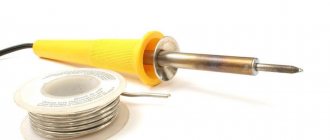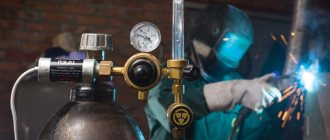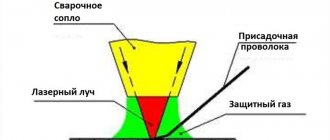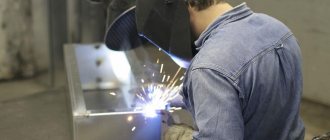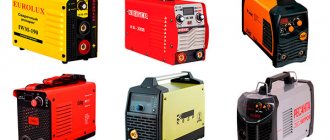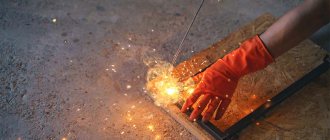Increasingly, ultrasonic vibrations are used in various fields of industrial activity. When performing welding work, ultrasound makes it possible to increase the mechanical properties of seams, reduce the level of self-stress of materials and their deformation, which is observed during traditional welding work.
The ultrasonic welding cycle determines the equipment used, the connection method and the pulse duration. Ultrasonic welding can be divided into mechanical and manual, single-sided and double-sided, press and continuous.
Working with plastic parts
Ultrasonic welding of plastics occurs due to artificially induced mechanical vibrations that cause heating at the point or zone of interaction with the material.
The process itself can be divided into two stages. In the first of them, the material is heated, which leads to diffusion at the site of interaction, and in the second, strong bonds are formed in the parts being welded, and due to this, a fused, permanent connection is obtained.
How it all happens
Conventionally, the ultrasonic welding process can be divided into the following parts:
- a generator capable of producing electrical ultrasonic vibrations at a frequency of 20,000 Hz is connected;
- a special converter is used that converts previously generated electrical vibrations into longitudinal mechanical ones;
- a waveguide is connected perpendicular to the location of the future welding point, which carries out longitudinal vibrations;
- mechanical energy is converted into wave energy, the material goes into a fluid state due to the applied static pressure (this ensures a reliable connection of the connection);
- dynamic forces applied to the product increase the temperature at the heating site.
Ultrasonic welding of plastic occurs according to a similar scheme. In addition, other materials (both dissimilar and homogeneous) can be connected to each other, providing the required level of melting temperature.
The key point in such work is the reliability and stability of the technological process. It is for this purpose that for each case of ultrasonic welding of plastics, the optimal mode is determined separately.
Peculiarities
The main features of this type of welding are that connections can be made in the most inaccessible points of products. It does not matter what condition the product surface is in (clean or dirty). The possibility of overheating of the plastic due to local heat release is eliminated.
Reliable permanent connections are obtained even at a great distance from the point of ultrasonic energy input. Low heating time of the material ensures fast welding.
Ultrasonic welding of polystyrene
Ultrasonic welding of polystyrene products is used for the manufacture of various containers and vessels, toys, sporting goods, as well as for packaging food products, medicines, cosmetics, etc. Depending on the shape of the product and the properties of the material, resistance and transfer welding or a combination of these methods is used . Each of the currently produced polystyrenes (block, suspension, emulsion and impact-resistant) has a different weldability - from the best for block to the worst for impact-resistant polystyrene.
When welding polystyrene products, one of the important factors influencing the process of forming welds is the quality of the surfaces being joined. A good geometric shape and proper surface preparation not only facilitate welding, but also help to increase the strength of the seam, increase the productivity of the process and allow one part of the welded product to be strictly fixed relative to another part.
The cutting of the edges can vary in shape, but basically one of the joined parts must have a protrusion that fits along the entire length into the corresponding groove of the other part (Fig. 20). The parts to be joined must have the smallest contact surface; therefore, the groove is made flat and the protrusion is sharp. The tip of the protrusion must contact the surface to be joined in a very small area, which is reduced almost to a line. This contributes to the concentration of mechanical energy on the protrusion, accelerating the process of heating and welding of plastics.
The best is the V-shaped groove of the welded edges, which is used to connect the parts shown in Fig. 20, a. A V-shaped protrusion is made on the upper part, and a V-shaped groove is made on the lower part. The height of the protrusion should be 0.05-0.030 mm greater than the depth of the groove. With this type of connection, better fluidity of the heated material under pressure is achieved and the seam has a good appearance.
When welding joints, it is necessary to provide tolerances for the fluidity of the softened polymer, which is squeezed out of the weld area, forming a flash. If burr is undesirable, special seam designs are used to avoid polymer splashes (see Fig. 20, 6 and c). The polymer, brought to a viscous flow state, must connect the two mating surfaces, filling a gap of several tenths of a millimeter.
Rice. 20. Types of cutting the edges of the welded surfaces of the product.
The bead line along the seam and the bead extending beyond the seam indicate that welding has occurred. In cases where the tightness of the product is required, it is necessary that the welded parts have a bead line. However, the bead line generally detracts from the appearance of the product and should therefore be avoided, especially on polished surfaces.
Improving the appearance is achieved by a stepped design of the working part of the waveguide, while the protrusion is made so that an influx is formed on the inside of the product. Small-sized parts of simple shape are welded using one contact of the waveguide with the product, and the waveguide is installed perpendicular to the surfaces to be welded along the axis of symmetry of the connection. If the part is complex and the length of the weld is significant, then the number of points and the location of the introduction of ultrasonic vibrations are determined experimentally.
The weldability of rigid plastics is greatly influenced by the storage conditions of the parts being joined. Long-term storage of parts before welding leads to a decrease in the strength of the welded joint. The strength of the joint decreases especially strongly when welding parts that have undergone long-term storage in atmospheric conditions. Thus, to obtain high-quality welded joints, welding must be done either immediately after casting the parts, or the cast parts must be stored in dark, cold rooms. Storing parts in atmospheric conditions in the presence of solar radiation is unacceptable.
The use of ultrasound for welding parts of children's toys made of polystyrene made it possible to completely eliminate the process of gluing with dichloroethane, toluene and other solvents, the use of which leads to significant air pollution. The use of ultrasonic welding increases labor productivity and production culture.
Working with metal parts
Due to its ease of use, ultrasonic welding of metals has recently begun to be used more and more often. It also has a number of advantages over contact and cold welding. It is also extremely useful when working with microelectronics.
This technology has some similar features to cold shear welding. The permanent bond of metals occurs due to the simultaneous influence of mechanical vibrations of high frequency and a low level of compressive forces.
Ultrasonic welding of metals can be performed at lower temperatures, which makes it possible to connect heat-sensitive elements without damage.
It allows you to weld together parts of different thicknesses and dissimilarities (for example, weld copper and aluminum, aluminum and nickel, etc.). The strength obtained in this way reaches about 70% of the strength of the material itself.
Metal products can also be welded with composite, ceramic, glass materials, and semiconductors. Refractory metals are no less successfully welded.
Ultrasound capabilities
The ultrasonic method allows you to weld a variety of materials. A distinctive feature of the technology is the ability to work with particularly thin parts. Their minimum thickness can be 3-4 microns. The maximum value that can be welded in this way is 1-1.5 mm. Due to the influence of high-frequency vibrations, deformations do not appear and the correct appearance of the structure is maintained. For thicker parts (over 1.5 mm), it is more advisable to use other welding methods, since with ultrasound the reliability of adhesion of materials is lost.
Among the types of welding method, spot welds stand out, thanks to which a large area can be quickly connected in a short time. The distance between the points is set individually and depends on the thickness of the sides and future use. The points can also be placed directly close to each other to strengthen the connection in places with increased load. When using roller mechanisms, circular and even continuous seams are realized. This is used to create dense plastic packaging.
Based on the type of joints, ultrasonic welding most often involves lap joints. To do this, one side of the product is placed on the other. The impact on the material can be from one or both sides at once. When working with wire, T-joints are also made.
Despite numerous advantages, the method also has disadvantages. There are only two of them: the ability to work with relatively thin materials and the appearance of small marks from pressing the welding tip to the surface of soft products. But due to its high productivity, ability to join a variety of metals and polymers, as well as harmlessness to workers, this welding method will continue to be actively used in industry.
Specifics of the equipment used
Equipment used for welding with ultrasound is divided into devices that provide spot contour press, seam and seam-step welding.
The power of such machines ranges from 100 to 1500 W, and they most often operate at a frequency of 20,000 - 22,000 Hz.
The key element of the equipment design is the electromechanical oscillatory system. Its main purpose is to convert electrical oscillations set by the generator into mechanical ones at a constant frequency. This system determines the level and method of energy transfer to the welding point and sets the speed of vibrations.
Converter
An important part of an ultrasonic welding machine is the magnetostrictive transducer. Usually it is made with two rods, using thin metal plates made of magnetostrictive material, which reduces losses.
The most optimal materials from which converters are made are alloys of iron and cobalt. Nickel is also often used to complete packages in magnetostrictive converters.
It has all the necessary properties for this (sufficient elongation, high strength, less susceptible to corrosion and easy to solder). Typically, running water is used to cool this element.
Transformer
The main function of an elastic vibration transformer is the process of matching the operating characteristics of the converters and the waveguide.
It allows you to increase the oscillation frequencies at the output of the waveguide. Most often, step transformers are used, which have a high gain (from 4 to 6). \
The waveguide tool amplifies the shift frequency of the output end of the transformer and transfers energy to the point at which welding work is carried out. Its working surface is made in the shape that is optimally suited for the part being welded and the type of ultrasonic welding used.
The material used to make the waveguide and transformer must have good elastic properties, a low degree of attenuation, and a good degree of machinability using cutting.
An equally important component of the ultrasonic machine is the support. It is used for the purpose of fixing parts during welding work. Sometimes it can be used as an element for heating and cooling, or in the form of a sensor for more precise control over the welding process. This piece of equipment must be able to move, for which an automatic drive is used.
Briefly about settings
Ultrasonic welding equipment consists of the following components:
- electrical oscillation generator;
- acoustic unit with waveguide;
- press mechanism;
- process control equipment.
There is no need to make the device yourself, and there are a number of reasons for this. The first and main thing is that creating a machine will require a lot of mathematical and physical calculations. A minimal deviation will lead to resonance at the point of contact of the parts, which will reduce the quality of the welded joint.
Types of ultrasonic systems
Ultrasonic welding is classified according to a number of criteria. The first is the method of energy transfer. So they distinguish:
- contact;
- transfer welding.
The first is usually used for joining soft plastics, films, and synthetics up to 5 mm thick. The most common welding method is lap welding. The second is applicable when processing hard plastics (polystyrene, nylon, etc.). The connection is butt.
Other criteria for the classification of ultrasonic systems are:
- method of moving the waveguide (press - for one short movement of the element; continuous - for prolonged exposure to the welding area);
- method of dosing the introduced mechanical energy (with fixation of the time of exposure to the ultrasonic pulse, settlement or gap).
Unlike manual or semi-automatic work, where you can use different types of electrodes or wires, as well as change other process parameters, in ultrasonic welding equipment everything is calculated to the smallest detail. The process proceeds as follows:
- the generator creates an electrical impulse;
- vibrations are converted into a high-frequency sound wave;
- the wave is transmitted through the waveguide to the junction of the parts;
- here it creates resonance;
- the displacement of materials towards each other leads to their instantaneous connection.
Depending on the physical characteristics of the materials being connected, the vibration frequency is selected. Below are some examples of settings.
Ultrasonic Welding Equipment
Conventionally, all devices can be divided into three groups:
- stationary (machines);
- desktop;
- manual.
An example of the first group is the SportTex EU 1300 ultrasonic welding machine. Visually, it resembles a regular sewing machine.
Specifications:
- voltage - 220 V;
- frequency - 50 Hz;
- power - 1.5 kW;
- working surface - 50 mm;
- productivity - up to 10 m/min;
- operating pressure - up to 7 bar;
- operating frequency - up to 20 kHz;
- dimensions - 1200x1200x550 mm;
- weight - 110 kg.
The installation cost is at least 200 thousand rubles, so it is usually used in production.
More compact devices include a tabletop ultrasonic module for connecting tubes (small oblong containers, for example, for toothpastes, creams, etc.). The operating speed of desktop units varies from 0.3 to 1.5 s and depends on the width of the seam (up to 70 mm).
Other options:
- operating frequency - up to 35 kHz;
- power - up to 1.5 kW;
- pneumatic drive;
- dimensions - 533x261x219 mm;
- weight - 30 kg.
The cost of such installations is an order of magnitude lower than stationary ones.
The most compact devices for ultrasonic welding are used for riveting plastics, tacking small parts, and fixing elements to supporting structures. An example is the Handy Star manual machine. Its power, frequency and operating speed are similar to desktop devices, but the dimensions and weight are significantly lower, which is reflected in the cost. The instrument in question, in the sum of three dimensions, gives 720 mm, and the mass is only 4.5 kg. Such equipment is used for ultrasonic welding in the automotive industry, repair of tarpaulin products, and production of conveyor belts.
Searching for records using a filter:
Heat release
When carrying out ultrasonic welding, heat is generated at the point of impact of the device. This occurs due to the formation of friction between the surfaces of the materials in contact, as well as due to plastic deformations, without which any welding cannot be done.
The increase in temperature at the welding site is affected by the hardness of the material, its thermal capacity and thermal conductivity. The welding mode has a special influence on heating.
It is worth noting that an increase in temperature during ultrasonic welding does not greatly affect the quality of the connection. Practical studies have shown that the highest level of strength is achieved earlier than the maximum temperature in this process.
If you preheat the product, this will reduce the transmission time of ultrasonic vibrations and will lead to an increase in the strength of the joint obtained during welding.
What causes welding
The blanks are spliced under the influence of 3 factors:
- ultrasonic vibrations;
- compression with a force of 10-200 kgf;
- preheating.
The workpieces are spliced under the influence of ultrasonic vibrations.
Operating principle
Ultrasonic welding is based on the phenomenon of recombination. It consists in the breaking of some rigid bonds between atoms and molecules of a solid body and the emergence of others. The intensity of the process increases with increasing amplitude of particle vibrations. In “hot” welding technologies, they are given thermal energy for this; in this method, they are exposed to sound.
Ultrasonic welding diagram.
The merging of materials occurs in the following order:
- The waves produced by the sound generator “rock” the molecules of one of the blanks.
- The tight bonds between some of them are being destroyed.
- At the same time, new ones arise with molecules of the second blank. This is facilitated by the pressure exerted on the product.
Heat generated during the process
In the joint zone, heating of the workpieces is observed. It is due to the following reasons:
- plastic deformation;
- sound vibrations;
- friction of workpieces against each other due to vibrations.
Heating of the workpieces is caused by plastic deformation and sound vibrations.
Heat is released in an amount disproportionately less than during gas or electric arc welding. Only the thinnest workpieces are sensitive to it. To work with them, the welding machine is equipped with a cooling system. In most cases, it has to be used for 2-sided welding.
The friction of the joined surfaces against each other leads to the destruction of oxide and other films. This feature makes it possible to exclude preliminary cleaning of workpieces from the technological process, although it still remains desirable. Aluminum is most susceptible to the formation of a surface oxide film.
Advantages and disadvantages
When using this type of welding, a high level of productivity and a low level of costs are observed; voltage is not applied directly to the welding point, which avoids radio interference.
It becomes possible to make seams in a variety of conditions and on different scales, to combine several procedures (welding at one point and cutting at another). If you choose the right welding mode, the joint will be invisible; in addition, there is no need to use any additional reagents or devices.
Compared to the above advantages of ultrasonic welding, the disadvantages do not look so critical. Low welding power necessitates the use of a two-way energy supply method. There is also no way to control the quality of the seam at a sufficient level.
When performing welding work with your own hands, you need to use tabular data that indicates all the necessary parameters that are needed for high-quality ultrasonic welding.
P.S
After reading this article, there is no doubt that ultrasonic welding of plastics is a high-tech process for bonding polymer materials.
Its effectiveness (especially when using mechanical process control) determines the high quality of the seam, which does not stand next to other methods of joining parts.
No one can deny the fact that to make connections of ideal quality you need to practice a lot.
It seems possible to carry out work intuitively when a practicing master, based on experience, understands where and how it is necessary to perform this or that action.
However, even long-term welders sometimes have to make mistakes in this matter, after which their work takes on a truly professional character.
All novice craftsmen are recommended to at least try making connections using ultrasonic welding.
Good luck learning this method of joining structures!
Restrictions
The most important limitation that you should pay attention to is the size of the products welded in this way. It should not be more than 250 mm (length, width, height).
The size requirement is due to the fact that the output power of the sensor has its limits, it is not possible to produce too much power of ultrasonic waves, as well as problems in controlling the amplitude of oscillations.
Materials for which ultrasonic welding is used must be dry . In other words, the moisture content in them should be minimal, otherwise it is better to use vibration welding.
It makes no sense to use ultrasonic welding to fasten thick-walled parts. At least one of the elements being connected must be light, since it absorbs a large amount of energy.
Welding of plastics
This method was proposed and developed by Moscow Higher Technical University named after. Bauman together with MPEI (see Table 25). When welding plastics, mechanical movements of the end of the waveguide are perpendicular to the surfaces being welded and occur in the same direction with the applied pressure.
The welding machine includes the same elements as the installation for ultrasonic welding of metals (Fig. 128).
The main component of the machine is vibrator 1, made of permendur and cooled with water. The vibrator converts the high-frequency current received from the ultrasonic generator into mechanical vibrations, which are transmitted to waveguide 2, which simultaneously serves as an amplifier-concentrator of mechanical longitudinal vibrations and a working element.
When welding, the product is clamped between the end of the waveguide and a movable support 3, to which a force is applied that creates pressure during the welding process. Welding occurs when a high-frequency electric current is switched on to the vibrator winding. The high-frequency elastic vibrations that arise in the vibrator are transmitted through the end of the waveguide in the form of vertical mechanical movements of the same frequency.
The duration of the welding process, although very short, depends on the thickness and properties of the material being welded. In spot and press welding, the duration of excitation of elastic vibrations is regulated by an electronic time relay.
The working tool of an ultrasonic welding machine is an oscillation block (Fig. 129), consisting of a vibrator 1, a concentrator (waveguide) 4, a casing 2 through which cooling water flows.
Rice. 128. Ultrasonic plastic welding machine
Rice. 129. Oscillation block
The material of the vibrator package can be one of the magnetostrictive materials. The vibrator, operating at a frequency of 20 kHz, is a package made of thin sheets of permendur (K50F2) 0.1 mm thick. Package size 65 x 65 x 125 mm. A winding of 2.5 mm2 PV wire (32 turns) is wound around the package rods, the ends of which are connected to an ultrasonic generator. A high frequency current flows through the winding. As the current in the winding changes, the dimensions of the package and the length of the concentrator (waveguide) change. Minor mechanical vibrations of the vibrator package (amplitude 5–10 μm) can be increased by 3–10 times by transmitting them through a waveguide with a decreasing cross-section.
The waveguide can be of various shapes: stepped, conical, exponential. The greatest amplitude is achieved with the exponential form. The dimensions of the waveguides are calculated depending on the vibration frequency and welding conditions.
Vibrator 1 and concentrator 4 are attached to casing 2 by diaphragm 3 (Fig. 129). The diaphragm is placed at the displacement node, where the vibration amplitude is zero. Waveguide 4 is made of StZ steel. Vibrator 1 is soldered to waveguide 4 with silver solder.
Satisfactory results are also obtained when soldering with POS-70 solder. To improve the use of elastic vibrations, the open wall of the vibrator rests against a rubber gasket 5, which serves as a reflector.
The UPT-14 installation, developed at the Moscow Higher Technical School named after. Bauman (Fig. 130), is intended for sealed welding of polyethylene tubes filled with food products. Single-position installation. The need to seal the product without access to air required welding of the tube shank to the packaged substance. The installation consists of a frame with a trunk, a welding unit, a pressure mechanism with a support, an electrical installation control system, a remote control and a control pedal. The welding unit is located horizontally and is permanently fixed. The support can be moved horizontally (travel 25 mm).
The installation works in this sequence. The tube to be welded is placed between the waveguide and the support, the operator presses the pedal, closes the circuit for turning on the electronic relay and the power circuit for the solenoid valve.
Fig. 130 Installation of UPT-14
The tube is pressed by the support against the working end of the waveguide by the movement of the pneumatic cylinder rod. The amount of welding pressure is controlled by a pressure gauge. Ultrasound is turned on, welding occurs. Remove the cooked tube and serve the next one. The welding cycle can be automated. At certain intervals of time required to feed the tube, the support is tightened and the ultrasound is turned on without operator intervention.
Technical characteristics of the UPT-14 installation
| Limits of regulation of welding force value, kgf | 5—200 |
| Welding duration, s | 0,8—3 |
| Converter power PMS-11, kW | 1,2 |
| Converter resonant frequency, | 19,6 |
| Water consumption for converter cooling, l/min. | 2 |
| Thickness of welded material, mm | 0,6+0,6 |
| Weld width, mm | 1,5 |
| Productivity, pcs/min | 15—20 |
| Overall dimensions, mm | 540X1100X1200 |
| Weight, kg | 260 |
- Back
- Forward
Application of KM
Ultrasound is widely used in the scientific field. With its help, scientists study a number of physical properties of substances and phenomena. In industry, ultrasound is used for degreasing and cleaning products and working with difficult-to-process materials. In addition, vibrations have a beneficial effect on crystallizing melts. Ultrasound provides them with degassing and grain refinement, increasing the mechanical properties of cast materials. Oscillations help relieve residual stress. They are also widely used to increase the rate of slow chemical reactions. Ultrasonic welding can be used for various purposes. Vibrations can become a source of energy for the formation of seam and point joints. When the weld pool is exposed to ultrasound during crystallization, the mechanical properties of the joint are improved due to the refinement of the weld structure and the intensive removal of gases. Due to the fact that vibrations actively remove dirt, artificial and natural films, parts with oxidized, varnished, etc. surfaces can be joined. Ultrasound helps reduce or eliminate intrinsic stresses that appear during welding. Vibrations can stabilize the components of the compound structure. This, in turn, helps prevent the possibility of spontaneous deformation of structures later. Ultrasonic welding has recently found increasing application. This is due to the undoubted advantages of this connection method in comparison with cold and contact methods. Ultrasonic vibrations are especially often used in microelectronics.
Ultrasonic welding of polymer materials is considered a promising area. Some of them cannot be connected by any other method. At industrial enterprises, ultrasonic welding of thin-walled aluminum profiles, foil, and wire is currently carried out. This method is especially effective for joining products from dissimilar raw materials. Ultrasonic welding of aluminum is used in the production of household appliances. This method is effective when splicing sheet raw materials (nickel, copper, alloys). Ultrasonic welding of plastics has found application in the production of optics and fine mechanics devices. Currently, machines for connecting various elements of microcircuits have been created and put into production. The devices are equipped with automatic devices, which significantly improve productivity.
Collaborative design
As with other welding processes, joint design is an important step in product development. When designing a connection, many factors must be taken into account, such as the materials being welded, the thickness of the parts, the operating conditions of the final product, aesthetics and others. A narrow contact zone between the parts being connected is an important design attribute. This reduces the energy required to form the surface layer of molten plastic. The fitting of parts must ensure the necessary alignment without compromising the characteristics of their surface.

